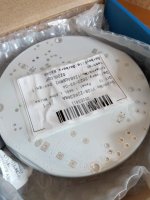Wow!!
She's got amazing talent (and great lab technique -- notice the component tester in photo #2). An inspiration to diy-ers of all ages. Thanks for posting these!
She's got amazing talent (and great lab technique -- notice the component tester in photo #2). An inspiration to diy-ers of all ages. Thanks for posting these!
This is absolutely woderful! Thank you for sharing a beautiful moment.
Cool, hopefully be replyong to this I will be made aware of the kit when available. It looks great!...
I've been chatting with Nelson Pass and Jason behind the scenes and am happy to announce that I will be putting together a complete kit for this design! Since the target is newbies, offering a full kit makes the most sense IMO. The first run will likely be a limited quantity group buy type affair, but I do hope to make these available on a continuous basis for all members. Be on the lookout for a new thread sometime after I update and test my new revision in this thread.
...
.......
Here's my 11-yr-old daughter ....
that's proper!
in few years Gorgeous one will be better than her Pa, even in amps making
every Parent's dream


Wow!!
She's got amazing talent (and great lab technique -- notice the component tester in photo #2). An inspiration to diy-ers of all ages. Thanks for posting these!
This is absolutely woderful! Thank you for sharing a beautiful moment.
These kits should be sold to primary schools all around the world at no profit, or subsidised by governments as a part of the curriculum.
... how much did the whole kit cost you to put together?
The big unknown is: in what quantity? Everything gets a lot cheaper when you buy many units. So to help you discover how much it might cost someone to create 50 monoblock kits, here's the Detailed Parts List for my RACAM rev.A PCB.
Please note: this is DEFINITELY NOT the parts list for Nelson Brock's PCB shown in post #1. This one has twelve more components (LRC+LRC filter, glow LEDs, etc). Less obviously, this spreadsheet lists parts which fit the PCB footprints I happened to plop down on my layout. I am absolutely certain that Nelson Brock plopped down different footprints on his PCB, and thus his board will require different parts. Just look at the black electrolytic caps in post #1, versus the red electrolytic caps in RACAM. Incompatible and inconttthheevable (link). And I am certain there are several more footprint incompatibilities. If you're building or copying Nelson Brock's board, use his parts list (which I don't have).
_
Attachments
I really like Brock's rethinkng on this and also Mark's extensions. Great stuff all. If either board becomes available please let me know. And a full kit would be a bonus! Many thanks!
Gerber files are not available. However this may be of interest
https://www.diyaudio.com/community/...s-for-racam-round-aca-monoblock.384057/latest
https://www.diyaudio.com/community/...s-for-racam-round-aca-monoblock.384057/latest
Thanks Mark, nice of you to offer this option. I recently did the exact same thing when ordering a batch of Get SET Go 6B4G tube amp and it went very smooth.
Could you offer the Global Economy shipping that JLCPCB offers instead of DLH ?
Thanks
Eric
Could you offer the Global Economy shipping that JLCPCB offers instead of DLH ?
Thanks
Eric
I love the design of the amp!
It shows the true spirit of DIY, where designs break away the standard black box form factor.
The last time I recall a lot of creativity in case design was when the 47 Labs Gaincard was reverse engineered, and people started to build really interesting cases to house their Gainclones.
Good luck with the DIYAudiostore effort!
It shows the true spirit of DIY, where designs break away the standard black box form factor.
The last time I recall a lot of creativity in case design was when the 47 Labs Gaincard was reverse engineered, and people started to build really interesting cases to house their Gainclones.
Good luck with the DIYAudiostore effort!
Hi all,
Just want to set some expectations. I haven't committed to selling these through the diyaudio store. Jason is open to the idea, but it will require consistent supply and somewhat different logistics compared to a group buy. I'm starting with the group buy model to iron out any issues and then it might progress to a product in the forum store.
In the meantime, I'd like some feedback on a potential design change. Automatically setting the bias using an optocoupler (4N35?) would eliminate the measurement and potentiometer adjustment steps in getting the amp setup and potentially removes a source of user error. I'm not an electrical engineer so I'd have to lean on the community to get it integrated into the design, but even before that I want to hear what people think. The component cost difference should be negligible. Is it worth having the amp self bias? Is there something we lose by getting rid of the manual adjustment pot? Maybe getting new builders used to taking measurements and making adjustments is a valuable learning experience and worth the potential error source.
Just want to set some expectations. I haven't committed to selling these through the diyaudio store. Jason is open to the idea, but it will require consistent supply and somewhat different logistics compared to a group buy. I'm starting with the group buy model to iron out any issues and then it might progress to a product in the forum store.
In the meantime, I'd like some feedback on a potential design change. Automatically setting the bias using an optocoupler (4N35?) would eliminate the measurement and potentiometer adjustment steps in getting the amp setup and potentially removes a source of user error. I'm not an electrical engineer so I'd have to lean on the community to get it integrated into the design, but even before that I want to hear what people think. The component cost difference should be negligible. Is it worth having the amp self bias? Is there something we lose by getting rid of the manual adjustment pot? Maybe getting new builders used to taking measurements and making adjustments is a valuable learning experience and worth the potential error source.
In the original ACA, there is a ZTX450 transistor called "Q3". It sets the output stage bias current, in exactly the same way that a 4N35 optocoupler sets the output stage bias current in the First Watt M2 / M2x. The ACA is self-biased, its output stage Class-A bias current is fixed and regulated, just like the M2.
The 5K potentiometer called "P1" in the original ACA circuit, sets the output stage equilibrium voltage, i.e. the voltage at drain of Q1 when there is zero input signal. Nelson specifies a target value for this equilibrium voltage, which will give approximately symmetrical clipping. And that ensures maximum possible output swing, unclipped.
I think you may need to enlist our crafty and fearless Zen Mod, to come up with a circuit to replace P1, that works equally well or better, while adding very few extra components for newbies to stuff and solder. It might not be simple to do, while keeping the amplifier free of unwanted oscillations. But ZM is a sneaky one and he might pull off an amazing magic trick.
The 5K potentiometer called "P1" in the original ACA circuit, sets the output stage equilibrium voltage, i.e. the voltage at drain of Q1 when there is zero input signal. Nelson specifies a target value for this equilibrium voltage, which will give approximately symmetrical clipping. And that ensures maximum possible output swing, unclipped.
I think you may need to enlist our crafty and fearless Zen Mod, to come up with a circuit to replace P1, that works equally well or better, while adding very few extra components for newbies to stuff and solder. It might not be simple to do, while keeping the amplifier free of unwanted oscillations. But ZM is a sneaky one and he might pull off an amazing magic trick.
it's trivial to ensure circuit output self-centering to mid-rail voltage..... but, for those in jeopardy of messing up so simple existing setting procedure (tweedledee with one pot while observing one DVM screen), much larger jeopardy is increased number of components, needing to be laid down in appropriate place and soldered properly
Pa is dangerously close to spoiling us just too much ...... there is a fine edge between making our life easier, getting Flock more amassed ........ and getting amassed Flock of myriad Lego-scaling-idiots
so, some actual sweating here and there is very cunning

Pa is dangerously close to spoiling us just too much ...... there is a fine edge between making our life easier, getting Flock more amassed ........ and getting amassed Flock of myriad Lego-scaling-idiots

so, some actual sweating here and there is very cunning
- Home
- Amplifiers
- Pass Labs
- ACA Redux



